Yes, the season will be remembered for that day in late May, when I arranged, but was then lead by two fine fellows to hunt and find the Kentish Burnt (Tip).
The season will also be remembered for being the driest on record, an amazing long dry and hot spell stretched from the beginning of May through June, July and into August. The early species were fine, and many seemed to thrive, but as the ground dried out, it seemed it was the Bee that suffered the most, with numbers down to almost single figures at the coastal location.
The season began, with me seeing the first flowering spike, on April 20th. I had been round a few orchid sited before then, and it was clear the size and numbers of rosettes promised a stunning season. I hoped so.
I am now a member of the Hardy Orchid Society (HOS), and several members were asking about the progress of the Early Spiders down on Samphire Hoe, so I made several trips until on the 20th, a single spike was opening, with the flower in a horizontal position, but it counted.
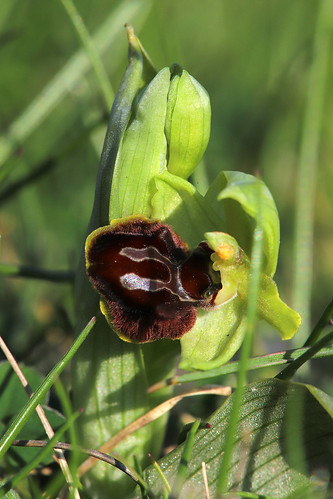 Further along the path, I found a few other open spikes, though numbers did seem better than 2017, but were a fraction of the glut of the year previous.
Further along the path, I found a few other open spikes, though numbers did seem better than 2017, but were a fraction of the glut of the year previous.That day I counted seven spikes with open flowers. There would be days when there were hundreds.
 The next day saw me find the first Early Purples open, Bonzai used to have a large population, but growing so close to the main path, and even on the path, means many spikes get trampled.
The next day saw me find the first Early Purples open, Bonzai used to have a large population, but growing so close to the main path, and even on the path, means many spikes get trampled.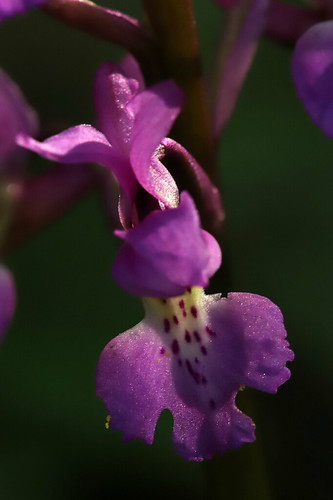 That day, the 21st April, I also found my first partially open COmmon Twayblade. These would be open still into July in some locations.
That day, the 21st April, I also found my first partially open COmmon Twayblade. These would be open still into July in some locations. Just to prove it had an open flower:
Just to prove it had an open flower: The nearby Lady Orchids were well advanced, many spikes were reaching for the sky, with the trips showing purple where in a week or so, flowers would pop open.
The nearby Lady Orchids were well advanced, many spikes were reaching for the sky, with the trips showing purple where in a week or so, flowers would pop open. A week later, on the 26th, there was over 60 flowering spikes down on the Hoe, with many more spikes showing. Little did we know, it would be a question of whether they reached flowering before the bone dry conditions and heat cooked them.
A week later, on the 26th, there was over 60 flowering spikes down on the Hoe, with many more spikes showing. Little did we know, it would be a question of whether they reached flowering before the bone dry conditions and heat cooked them.The 26th also saw us at Sandwich Bay to check on the Green Wing: I avoid this colony most of the time, instead going to Marden, becasue irate golfers shout at we orchidists as we scuttle about as they want to play their shots, so I go there at the end of the day, so capture spikes in the warm golden light.
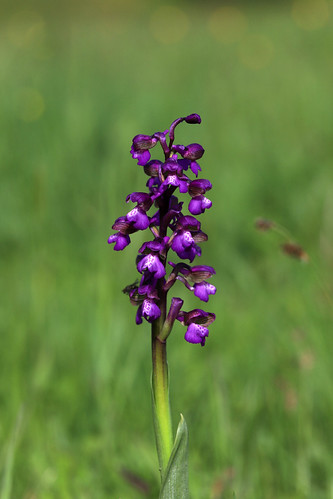 April 28th brought the first Fly spike open, it was going to be a memorable season for them, but for now, in deep undergrowth more and more spikes would open, if you could find them, of course.
April 28th brought the first Fly spike open, it was going to be a memorable season for them, but for now, in deep undergrowth more and more spikes would open, if you could find them, of course.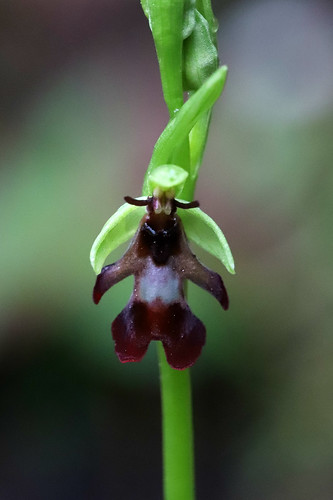 My friend Mark shared with me a new site, which we would visit a half dozen times through the spring, as it had hundreds and hundreds of Greater Butterfly spikes, but for now, it had hundreds of Early Purples, flocking together on the side of a chalk down, looking gorgeous in the sunshine, and mixed in were a few Fly too. A great site.
My friend Mark shared with me a new site, which we would visit a half dozen times through the spring, as it had hundreds and hundreds of Greater Butterfly spikes, but for now, it had hundreds of Early Purples, flocking together on the side of a chalk down, looking gorgeous in the sunshine, and mixed in were a few Fly too. A great site.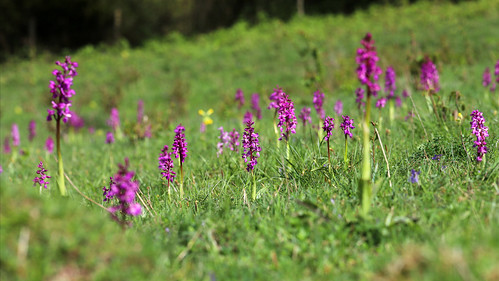 We paid our first visit to Marden on the 26th, and already hundreds of Green Wing spikes were open, including a few var. alba too, it would get even better in the weeks that followed.
We paid our first visit to Marden on the 26th, and already hundreds of Green Wing spikes were open, including a few var. alba too, it would get even better in the weeks that followed.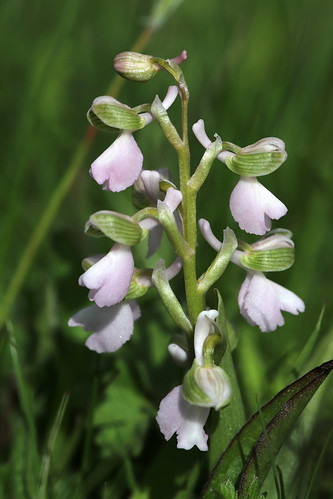 Just two days later, we were on another wooden chalkbank where we saw the first Lady in flower. This site is always the earliest, and with the fine Bluebell display, is always woth a visit.
Just two days later, we were on another wooden chalkbank where we saw the first Lady in flower. This site is always the earliest, and with the fine Bluebell display, is always woth a visit. On May 3rd, I found a colony of Early Spiders growing in our village. I had heard there were some, but there they were, growing in the middle of a path, where they could get trampled.
On May 3rd, I found a colony of Early Spiders growing in our village. I had heard there were some, but there they were, growing in the middle of a path, where they could get trampled.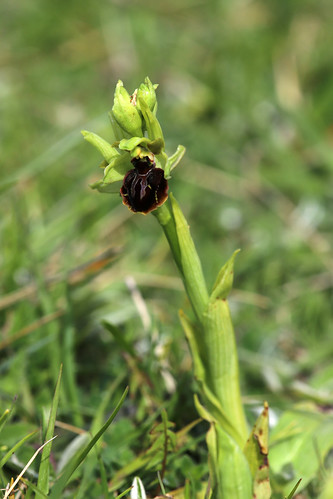 Meanwhile, at Kingsdown, I saw 24 flowering spikes, the best display seen in the seven seasons I had been going there. But as the weather warmed up, there was increasingly less time to get round all the sites, or back to already visited sites, like this.
Meanwhile, at Kingsdown, I saw 24 flowering spikes, the best display seen in the seven seasons I had been going there. But as the weather warmed up, there was increasingly less time to get round all the sites, or back to already visited sites, like this.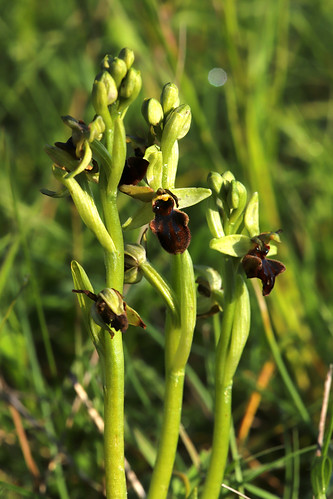 It was turning out to be a fine season for Fly; at the best site I know, I captured this beauty in a column of sunlight.
It was turning out to be a fine season for Fly; at the best site I know, I captured this beauty in a column of sunlight.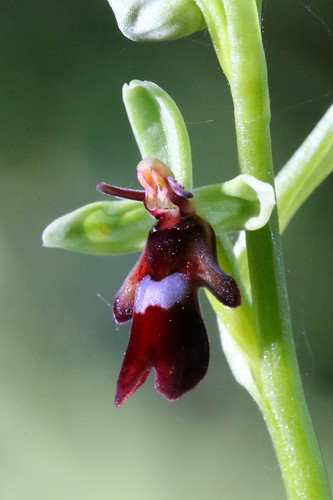 By the end of the first week of May, Lady were open just about everywhere, but it would be another week before the woodland Lady would show herself, but I would be waiting.
By the end of the first week of May, Lady were open just about everywhere, but it would be another week before the woodland Lady would show herself, but I would be waiting.I took two weeks off in May, and on the first day off, Jools dropped me off at the National Trust place, and I walked back, and on the way I found many hundreds of spikes, most between there and Langdon Hole, but still, to see the tiny orchis clinging on to the side of the cliffs, just above the waves crashing below, was fabulous.
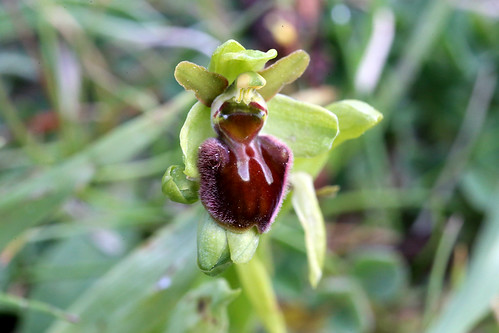 One of the biggest disappointments of the season was the Birds Nest. Near Dover there is a small wood that has a colony that returns year on year, they move about a bit, but is always reliable. This year ust four spikes showed, and only one set seed, meaning it may die out, which would be a shame....
One of the biggest disappointments of the season was the Birds Nest. Near Dover there is a small wood that has a colony that returns year on year, they move about a bit, but is always reliable. This year ust four spikes showed, and only one set seed, meaning it may die out, which would be a shame....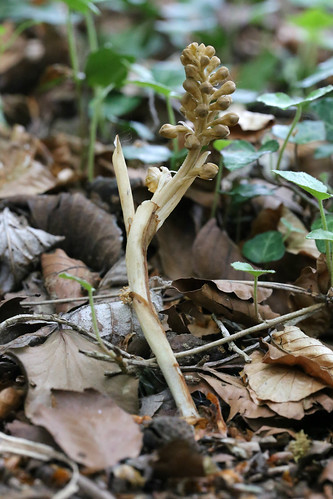 But in the same wood, the White Helleborines were in large numbers, and many of a larger size than normal, and hidden beneath a small tree I found a rare variant, a var. chloriantha, which I would go back to again and again until it opened its single flower. The spike and leaves were a sickly yellow colour, but the flower a normal white.
But in the same wood, the White Helleborines were in large numbers, and many of a larger size than normal, and hidden beneath a small tree I found a rare variant, a var. chloriantha, which I would go back to again and again until it opened its single flower. The spike and leaves were a sickly yellow colour, but the flower a normal white.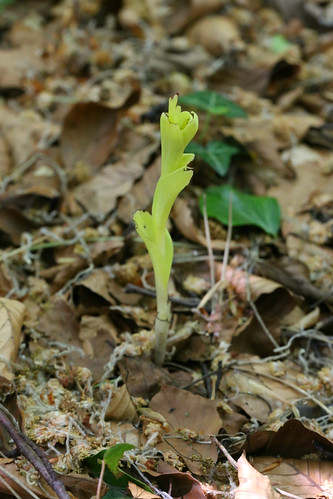 By the middle of May, the woodland Lady were coming out, opening their delicate flowers, and at one site, four pure white var. albas showed well, although one did show a few pale pink spots as it got older, the rest remained pure white.
By the middle of May, the woodland Lady were coming out, opening their delicate flowers, and at one site, four pure white var. albas showed well, although one did show a few pale pink spots as it got older, the rest remained pure white.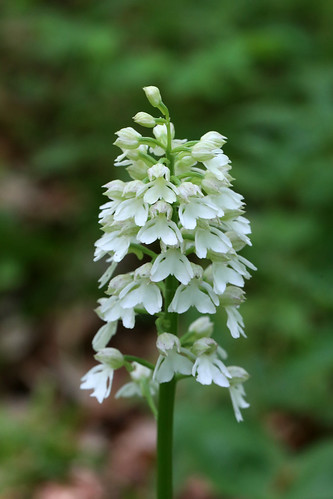 Whilst nearby, was the darkest hypercoloured one I have seen, the ying and yang of Lady, and yet the same species, no wonder people get confused.
Whilst nearby, was the darkest hypercoloured one I have seen, the ying and yang of Lady, and yet the same species, no wonder people get confused.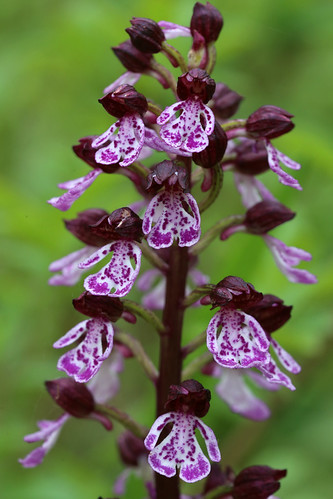 On May 15th, I met wth a couple over from Australia to guide them round the Kentish sites. First port of call was at up on the down near to Folkestone, where I showed them were the Late Spiders would show in a week or so. Imagine my surprise when they spotted a single flowering spike. It might not look much, but this is one of the rarest plants in the UK, and John found it on his own.
On May 15th, I met wth a couple over from Australia to guide them round the Kentish sites. First port of call was at up on the down near to Folkestone, where I showed them were the Late Spiders would show in a week or so. Imagine my surprise when they spotted a single flowering spike. It might not look much, but this is one of the rarest plants in the UK, and John found it on his own.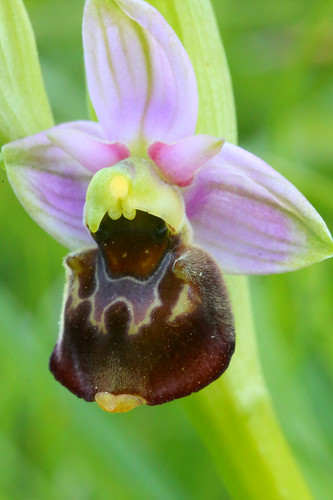 The Dover colony of Man Orchids was very late this year, the coastal "lemon" ones were very advanced, and on May 17th looked like this:
The Dover colony of Man Orchids was very late this year, the coastal "lemon" ones were very advanced, and on May 17th looked like this: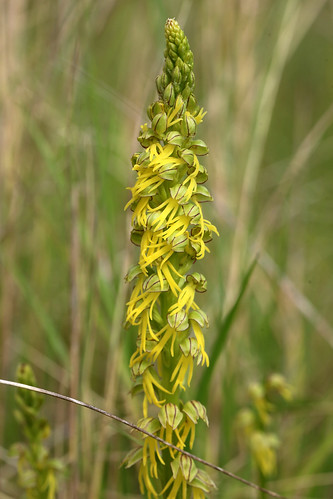 The next day, We went to PGD, and as I searched the familiar areas for Monkey, Jools found three new ones, all early flowering ones too,
The next day, We went to PGD, and as I searched the familiar areas for Monkey, Jools found three new ones, all early flowering ones too, 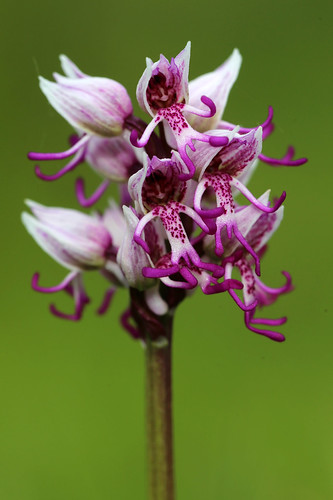 The same day saw me at Barham looking for the Lesser Butterfly where just three spikes had show, one was flattened as it grew in the middle of the bridleway, a second got nibbled by rabbits, so just this one reached flower and set seed.
The same day saw me at Barham looking for the Lesser Butterfly where just three spikes had show, one was flattened as it grew in the middle of the bridleway, a second got nibbled by rabbits, so just this one reached flower and set seed.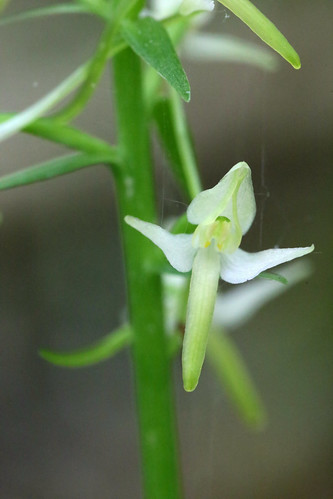 There are many variations to the more familiar shapes and colours of orchids, and so it is the thrill of seeing one of them makes us go year after year to the same sites, just in case. I thought I had found a variant of the Fly, normally called a Wasp Orchid, but turned out to be one that had not developed properly. I snapped it from all angles just in case. As you do.
There are many variations to the more familiar shapes and colours of orchids, and so it is the thrill of seeing one of them makes us go year after year to the same sites, just in case. I thought I had found a variant of the Fly, normally called a Wasp Orchid, but turned out to be one that had not developed properly. I snapped it from all angles just in case. As you do.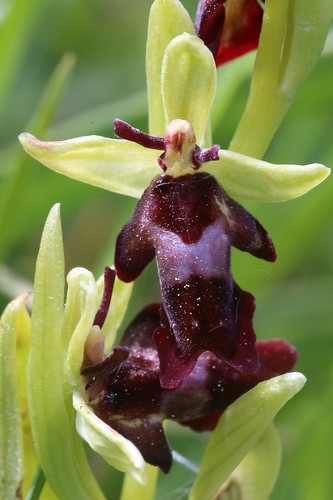 By the 22nd, Man Orchids all over were open, including the local colony near to me.
By the 22nd, Man Orchids all over were open, including the local colony near to me. 

No comments:
Post a Comment